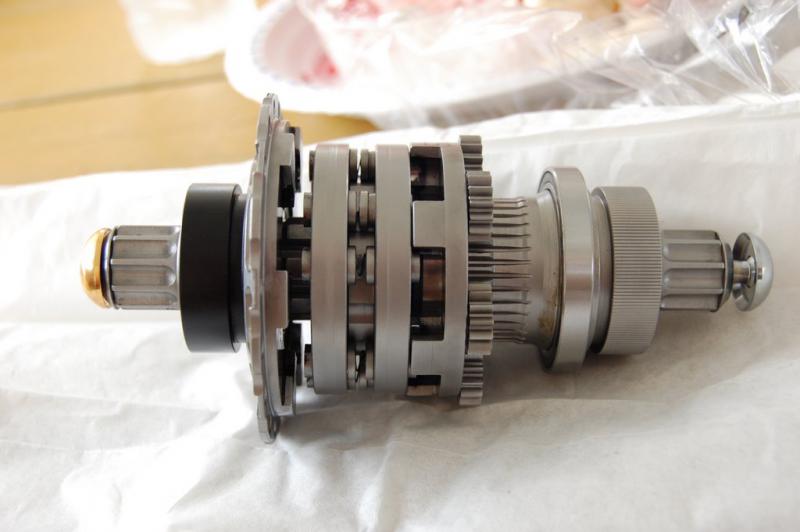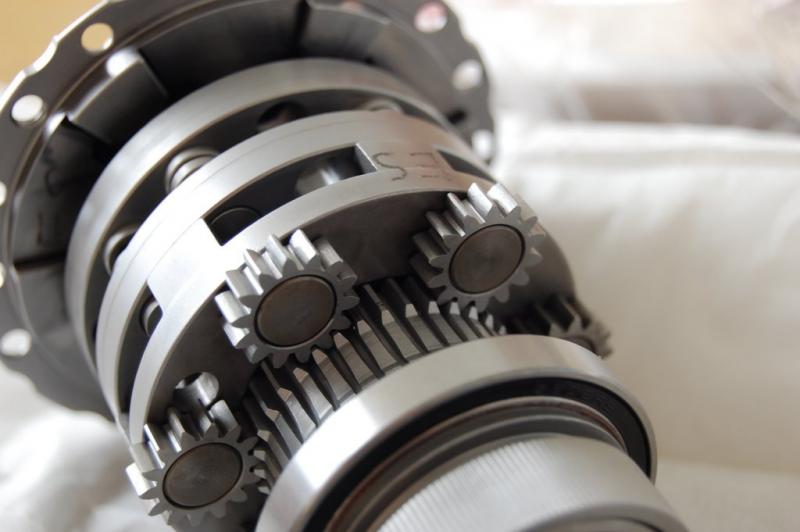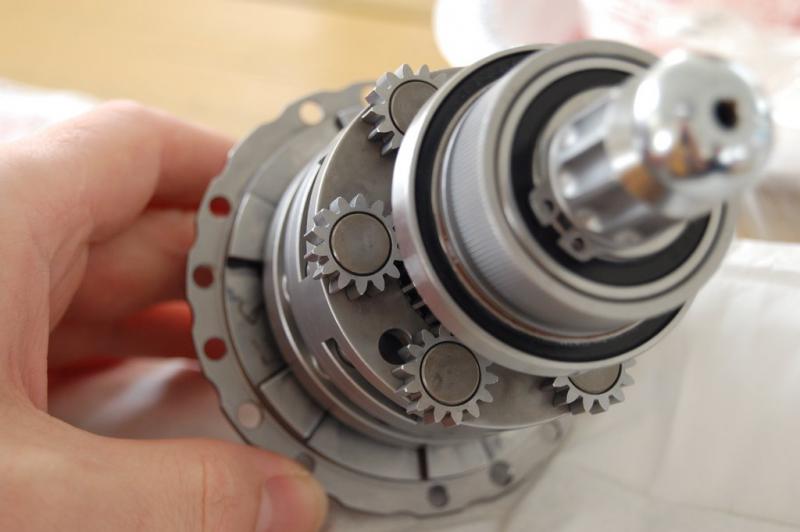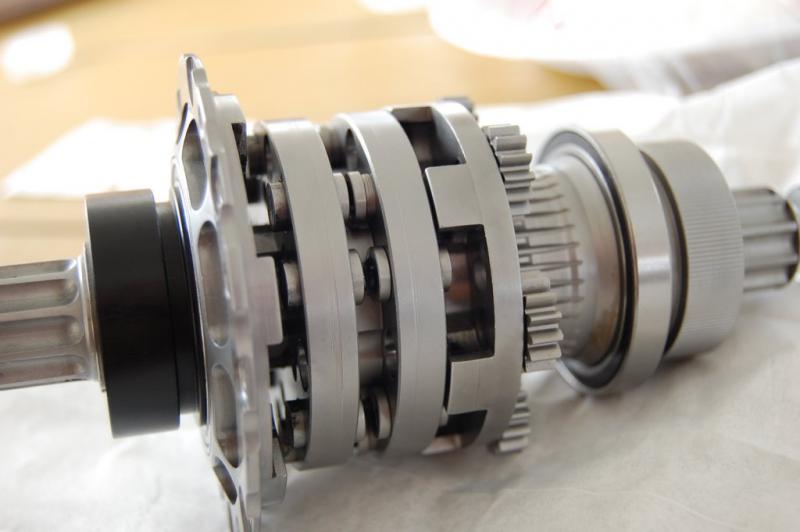There are enough available photos on the web where it’s possible to determine them
Please show me. I attached some pics I know of.
From the second picture I can confirm the 14 cogs of the planets (which is not relevant to calculate gearing ratio).
From the first two pictures you can guess anything between 32 and 36 cogs of the sun.
I don’t know any picture that reveals the number of cogs of the annulus.
ring gear teeth (64) = 2 x planet gear teeth (14) + sun gear teeth (36)
That’s a convincing argument indeed. If we want to have a ratio of 17/11 under the boundary condition of planets with 14 cogs the sun needs to have 6n cogs and the annulus 11n cogs with n a whole number. So the equation
11n = 6n + 2*14
needs to hold, resulting in
n = 28/5
which is not a whole number. So there is no such configuration possible. Slowly I start to give in …
I just built up a KH36 with hub M0501 and had to file down my frame’s inside bearing holders. I did not have to remove much material - more on the left side than on the right - but still less than a 1mm.
LuisBCN: This is not a major issue and doesn’t significantly weaken the frame. If you want a new Schlumpf KH26, I wouldn’t wait. Seriously, you could be waiting a very long time before this minor issue is fixed.
Agreed. A new batch of hubs was just produced - they are made in batches of 300. We’ll look at this for the next generation but that won’t be for quite a while.
On the frames, KH frames can’t get any thinner on the inside face and still maintain the standard bearing spacing. All I can do is try to control manufacturing quality on the weld bead, which can vary slightly in thickness. Before now this never mattered.
Kris
I had to shave off the inside face quite a bit on my KH36. It actually was not the weld that was rubbing. I did a first pass at shaving it down, and it would still rub intermittently. I did notice that there is some play in the bearing holders, so I think the wheel would shift to make it rub or not. I shaved more off, and now it doesn’t seem to rub anymore. I do hear a faint grinding sound from behind the dust cover on one side of the hub now. The cover on the other side had actually come off the hub from the rubbing, and I had a lot of grease leak out onto the frame (and my pants while riding around the plantsite at work). I put a little grease back in and put the cover back in place. It seems to be staying on for now.
I have a new hub with the dust shields and a 2011 KH 26 frame. I did not need to remove any material, clearance is tight, but I have had zero rub.
That said, it is mighty tight down there (0.5mm clearance per side) so if I ever developed any wobble or side to side play in the hub, it would rub for sure.
I’d like to see a 125mm spacing, a disc brake that is spindle or hub mounted, an option for a 25% step down or up, let’s see, uhhhh, yeah, that’ll do it for now 
At last I have got My old (266) hub back this week after waiting almost all year! One of my Hub bearing’s sezied up two days before Karapoti Classic this year  I unsezied it and over lubed the hub to race (ride).
I unsezied it and over lubed the hub to race (ride).
I think that the slow speed of fixing/repairing is too slow and I have Sold my Triton (with repaired and up dated Hub) 26" to a Very fast Unicyclist  so it’s going to a good home.
so it’s going to a good home.
BUT this will be the Last Schlumpf Hub for me? 
I’ll be building up a Design I have been working with the crankarms/hub not made SO wide  I’ll be working around 80 to 90mm wide hub bearing set up. A custom saddle (a Bike Saddle with a Handle) 3 or 4 speed and quick change wheel bearing set up.
I’ll be working around 80 to 90mm wide hub bearing set up. A custom saddle (a Bike Saddle with a Handle) 3 or 4 speed and quick change wheel bearing set up.
Unicycle design’s need up dating for the long ride’s that more People are riding, i.e. 50km’s +
See you out on the Tracks 
PeteG…
bouin-bouin, I respect your expertise on the subject, but I don’t think your number is correct. I’m not going into the internals of the hub, number of teeth on the cogs etc. I just focus on observations about revolutions. I just checked with my KH/Schlumpf 29", bought in July this year.
If your numbers are correct, then if the cranks turn 16 full revolutions, the wheel should turn exactly 25 full revolutions. This is an easy check on your number. But if I try this, the wheel does NOT turn a whole number of revolutions, in fact it does about 24 and three quarter turns.
However, if I turn the cranks 11 full revolutions, the wheel does exactly 17 full revolutions. I did multiples of 11 just to be more accurate, and the wheel keeps doing exactly 17 revolutions. So 17/11 must be the true in/out ratio of the KH/Schlumpf in high gear.
This holds for the latest batch of hubs, and also for quite early hubs. I used to own hub number 00000006 (have sold it this summer). When I just had it, I measured the ratio also to be 17/11.
This is very strange because it’s same as estimation from Greg Harper in 2006 when you measured your hub ratio at 17/11 if you remeber !
But it was based on an estimation of planet gear with 15 teeth, and according to photos, we are sure it’s not 15 but 14 !!!
Thanks for the link - I vaguely remember that discussion. Can we be sure that those photos are of actual production KH/Schlumpf unicycle hubs? If so, it is an interesting puzzle how to get to 17/11. I cannot fully fathom if this is impossible or not. But I’ll eat my hat if the ratio of my hub is not exactly 17/11.
Hugo presented recently photos from the inside on the last production batch. I asked him if it is possible to receive them in high quality, this should help a lot to check is any change on cogs
The photos I posted for sure are not from the latest batch.
Under the assumption of planets with 15 teeth there is exactly one possible configuration resulting in a 17/11 ratio (solving the equation 11n = 6n + 2*15). That is a sun wheel with 36 teeth and an annulus with 66 teeth.
I’m 100% sure that part of the production with small bearings was 36/14/64 = 1.5625; need to check for latest specification
There was one photo I posted and the quality does not allow to count any theeth  Also the other photos won’t help - and it wasn’t me who took the other pictures.
Also the other photos won’t help - and it wasn’t me who took the other pictures.
As far as I understood Florian, the gear ratio has never changed since he started to build these hubs.
is not necessarily true
2. planet gear teeth does not enter the calculation of gear ratio
I guess the numbers of teeth are 66 / 36 /14
66 and 14 can be seen in
Anyway, the planet gear needs to match with ring gear and sun gear; so ring gear primitive radius is the sum of sun gear and planet gear primitive radius
So ring gear teeth = 2 x planet gear teeth + sun gear teeth
66 cannot be seen on the photos mentionned in the link
I just did some more calculations under the following assumptions:
- the planet gears have 10 or more teeth
- the annulus (= ring gear) has 100 or less teeth
- the gear ratio is either 17/11 or 25/16
Actually there are very few possible combinations:
p; s; a; g
10; 44; 24; 17/11
14; 64; 36; 25/16
15; 66; 36; 17/11
20; 88; 48; 17/11
21; 96; 54; 25/16
a = #teeth annulus
s = #teeth sun gear
p = #teeth planet gears
g = gear ratio
Let me offer a new theory: from the first picture I posted before, a sun gear with 31 teeth seems reasonable. With that the annulus would turn out to have 62 teeth (planets with 14 teeth given), resulting in a gear ratio of 48/31, which is pretty close to 17/11. So after 11 revolutions of the cranks, the wheel would have performed 17.03 revolutions. That derivation of 0.03 is something that can easily be overseen.
BTW, I am still waiting for a response from Florian Schlumpf. He for sure should be able to answer that question.



